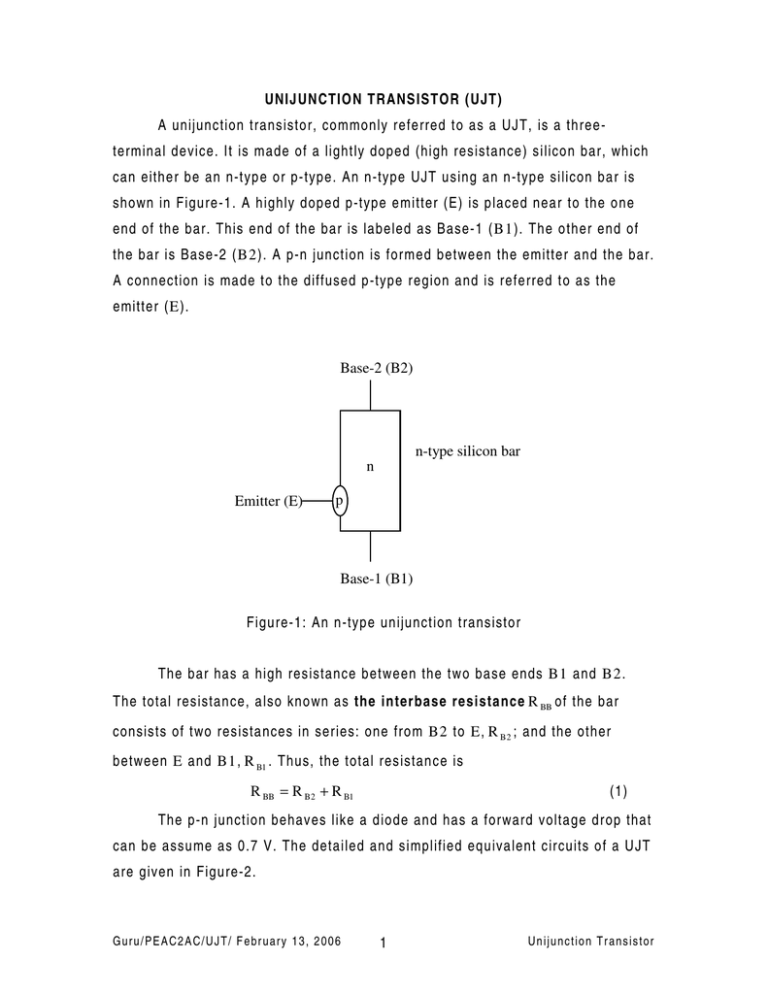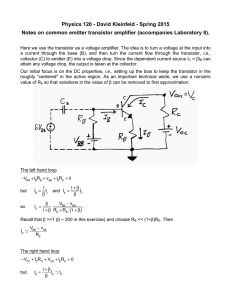A unijunction transistor, commonly referred to as a UJT, is... terminal device. It is made of a lightly doped (high... UNIJUNCTION TRANSISTOR (UJT)
advertisement

UNIJUNCTION TRANSISTOR (UJT) A unijunction transistor, commonly referred to as a UJT, is a threeterminal device. It is made of a lightly doped (high resistance) silicon bar, which can either be an n-type or p-type. An n-type UJT using an n-type silicon bar is shown in Figure-1. A highly doped p-type emitter (E) is placed near to the one end of the bar. This end of the bar is labeled as Base-1 (B1). The other end of the bar is Base-2 (B2). A p-n junction is formed between the emitter and the bar. A connection is made to the diffused p-type region and is referred to as the emitter (E). Base-2 (B2) n-type silicon bar n Emitter (E) p Base-1 (B1) Figure-1: An n-type unijunction transistor The bar has a high resistance between the two base ends B1 and B2. The total resistance, also known as the interbase resistance R BB of the bar consists of two resistances in series: one from B2 to E, R B 2 ; and the other between E and B1, R B1 . Thus, the total resistance is (1) R BB = R B 2 + R B1 The p-n junction behaves like a diode and has a forward voltage drop that can be assume as 0.7 V. The detailed and simplified equivalent circuits of a UJT are given in Figure-2. Gur u / PE A C2 A C/ UJ T / F ebr uar y 13 , 2 006 1 Un iju nc tio n T r ans is tor B2 + R B2 B2 + vD − E + VBB E + VEB R B1 _ + VBB VEB _ _ B1 _ B1 (a) (b) Figure-2: (a) Detailed, and (b) simplified equivalent circuits of a UJT When a positive voltage VBB is applied at B2 with respect to B1, the current in the n-bar is so small that it can be assumed as zero. The UJT is OFF. Let us now apply a positive voltage VEB at E with respect to B1. The device remains OFF until VEB = VP , where VP is known as the peak-point voltage. As soon as VEB tends to go above VP , the UJT will turn ON if and only if the emitter current I E ≥ I P , where I P is the peak-point emitter current. Consider this as the condition for the device to turn on. As soon as the emitter current begins to flow, the region between the emitter junction and the base B1 is flooded by holes (positive charges from the heavily doped p-region). Consequently, its conductivity goes up and the resistance of the region R B1 decreases a lot. This in turn decreases the emitterto-base voltage and increases the emitter current. This phenomenon continues until the emitter-to-base voltage becomes very small. This voltage is known as the valley-point emitter voltage ( VV ). The emitter current corresponding to the valley voltage is called the valley-point emitter current ( I V ) as shown in Figure-3. Gur u / PE A C2 A C/ UJ T / F ebr uar y 13 , 2 006 2 Un iju nc tio n T r ans is tor IE Negative resistance region IV IP VV VP VEB Figure-3: Voltage-current characteristic of a UJT Note that the peak-point voltage depends upon the applied voltage between the two bases such that VP = R B1 VBB + VD R BB It is commonly expressed as VP = η VBB + VD where η= R B1 R BB (2) is the intrinsic stand-off ratio. The intrinsic stand-off ratio is usually specified by the manufacturer. For example, for a 2N4948 or 2N4949 UJT, the following information is available. Symbol Minimum Typical Maximum η 0.55 ------ 0.86 R BB ,kΩ 4 7 12 I P , µA ------ 0.6 2 I V , mA 2 4 ----- VEB(SAT ) , V ----- 2.5 3 Max. f , kHz ---- 400 ----- Gur u / PE A C2 A C/ UJ T / F ebr uar y 13 , 2 006 3 Un iju nc tio n T r ans is tor In order to obtain an output signal from the UJT, we use external resistors R 1 and R 2 as shown in Figure-4. These external resistors are usually small as compared to R BB , so they may be ignored in making the calculations. VBB VBB • R2 R2 R B2 • R v B2 B2 R B2 + vD − E C v B1 B1 R1 E• + + v C (t) C V _ P v B2 • R B1 B1• R1 _ v B1 • Figure-4: Application of a UJT: (a) Actual circuit, (b) Detailed circuit The exact expression for the peak-point voltage is VP = VBB R B1 + R 1 + VD R BB + R 1 + R 2 The approximate expression, when the external resistors are ignored, is VP = VBB R B1 + VD = η VBB + VD R BB (3) The capacitor in the circuit begins to charge through R and the corresponding differential equation is RC Its general solution: dv C ( t ) + v C ( t ) = VBB dt v C ( t ) = VBB + A e − t / RC At t=0, the voltage drop across C is VV as long as the circuit has been oscillating for a long time. If the circuit is used as a delayed circuit (to be discussed next), the initial voltage drop across C can be taken as zero. Gur u / PE A C2 A C/ UJ T / F ebr uar y 13 , 2 006 4 Un iju nc tio n T r ans is tor Thus, A = VV − VBB Hence, v C ( t ) = VBB − (VBB − VV ) e − t / RC Let us assume that the capacitor takes TCH seconds to charge to VP . Thus, the charging time: V − VV TCH = RC ln BB VBB − VP (4) At this time the device will start conducting as long as I E ≥ I P . However, IE = VBB − VP R By equation the emitter current to the peak-value current, I E = I P , we can obtain the maximum value of R that will ensure conduction as R MAX = VBB − VP IP (5) Once the device switches on, the base resistance R B1 falls to a very low value and the capacitor discharges through R B1 + R 1 almost in no time. Thus, for all practical purposes we can assume that the time period of the output pulse is nearly equal to TCH . Let us simplify the expression by assuming that VV → 0, and VD can be neglected as long as ηVBB >> VD , then 1 TCH ≅ RC ln 1 − η (6) This expression, albeit approximate, is independent of the applied voltage VBB . When the capacitor voltage drops below VV , the device will shut off. In other words, to turn off the device, we should ascertain that or IE = VBB − VV ≤ IV R R≥ VBB − VV IV Gur u / PE A C2 A C/ UJ T / F ebr uar y 13 , 2 006 5 Un iju nc tio n T r ans is tor The equality sign in the above equation yield the minimum value of R as R MIN = VBB − VV IV (7) If we select R such that R MIN < R < R MAX , the device will make the circuit to oscillate with the oscillation frequency of f≅ 1 = TCH 1 V − VV RC ln BB VBB − VP (8) When R < R MIN , the device will stay on forever. On the other hand, when R > R MAX , the device will never turn on. Figure-5 shows the various waveforms when the device acts as an oscillator. v C (t) t (s) v B1 ( t ) t (s) VBB v B2 (t ) TCH 2TCH 3TCH t (s) 4TCH Figure-5: Various waveforms of a UJT oscillator Gur u / PE A C2 A C/ UJ T / F ebr uar y 13 , 2 006 6 Un iju nc tio n T r ans is tor Example: The following information is available for a UJT: VV = 2 V, I V =10 mA, η =0.6, R BB = 10 k Ω , and I P =1 µ A. If the forward voltage drop of the diode is 0.5 V, the applied dc voltage is 20 V, R 1 =100 Ω and C = 1 µ F, determine R so that the oscillation frequency is about 100 Hz. Solution: Although R 2 is not needed, the “Motorola Engineers Report” suggests that we should still use it and its value can be approximated as R 2 = 0.015 η R BB VS = 0.015 × 0.6 × 10,000 × 20 = 1800 Ω As you may have guessed it, it is not really a small resistor. Let us select a value of 2 k Ω for R 2 . From (2): R B1 = η R BB = 0.6 × 10 = 0.6 kΩ We can now determine the peak-point voltage using the exact expression as VP = VBB R B1 + R 1 6 + 0 .1 + VD = 20 + 0.5 = 10.58 V R BB + R 1 + R 2 10 + 0.1 + 2 For a frequency of 100 Hz, the time period, is T= 1 1 = = 0.01 s. f 100 Neglecting the discharging time, the charging time is TCH ≅ T = 0.01 s From (4): V − VV TCH = RC ln BB VBB − VP or 20 − 2 0.01 = R (1 × 10 −6 ) ln 20 − 10.58 R = 15.443 k Ω For sustained oscillations, R must be within its minimum and maximum values as computed below. R MIN = VBB − VV 20 − 2 = = 1 .8 k Ω IV 10 × 10 −3 R MAX = VBB − VP 20 − 10.58 = = 9.42 M Ω IP 1 × 10 − 6 The circuit oscillates because R fulfills the requirements. Gur u / PE A C2 A C/ UJ T / F ebr uar y 13 , 2 006 7 Un iju nc tio n T r ans is tor If we had the freedom to choose both R and C , we could have chosen R as the geometric mean of the minimum and maximum resistances. That is, R = R MAX R MIN = 1.8 × 9420 = 130.2 k Ω Had we selected R = 130 k Ω , then the capacitor would have been C= 0.01 = 118.79 × 10 −9 F 20 − 2 130 × 10 3 ln 20 − 10.58 Hence, we could have used C = 120 nF With these selected values, the time period is V − VV TCH = RC ln BB VBB − VP 20 − 2 = (130 × 10 3 )(120 × 10 −9 ) ln =0.0101 s 20 − 10.58 Finally, f= 1 = 98.99 Hz 0.0101 This frequency is about 1% lower than its desired value of 100 Hz. This is well within the approximations and the tolerances of the components. Gur u / PE A C2 A C/ UJ T / F ebr uar y 13 , 2 006 8 Un iju nc tio n T r ans is tor Problems: UJT Parameters for UJT: η =0.66, VD = 0.5 V, I V = 4 mA, I P = 10 µ A, and VV = 1 V. 1. In the circuit of Figure P1 , R = 10 kΩ , C = 2µF , R 2 = R 1 = 100 Ω , and VBB = 24V . Will the circuit oscillate? If yes, what is its oscillation frequency? Neatly sketch and label the voltage drop across the capacitor. What is the range of frequencies that can be obtained by varying R ? 2. In Figure P1, if R is a 5-k Ω resistor in series with a 100-k Ω potentiometer, C is 0.068 µ F, and VBB = 10V , what are the minimum and maximum oscillation frequencies? Gur u / PE A C2 A C/ UJ T / F ebr uar y 13 , 2 006 9 Un iju nc tio n T r ans is tor





